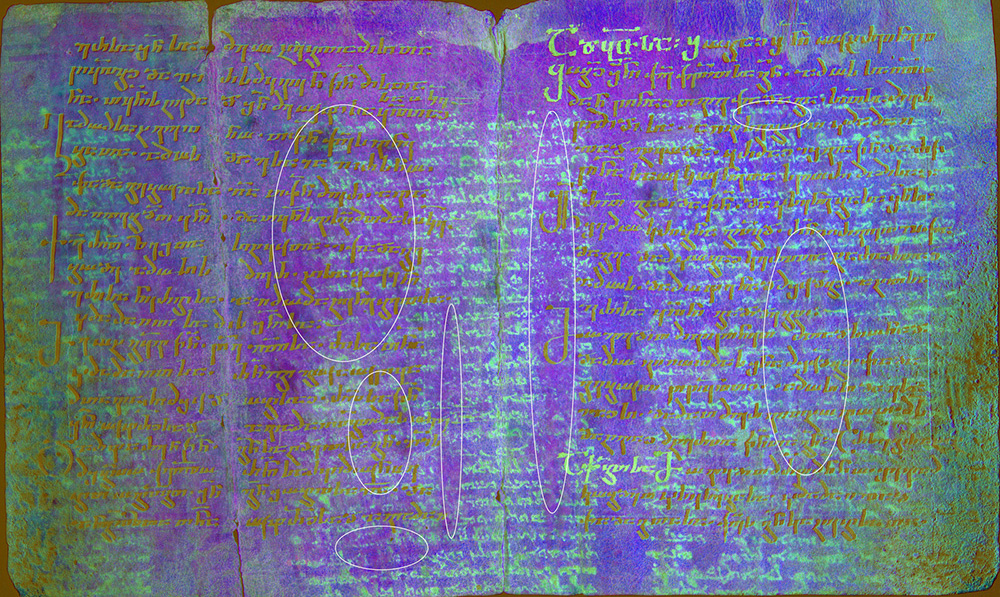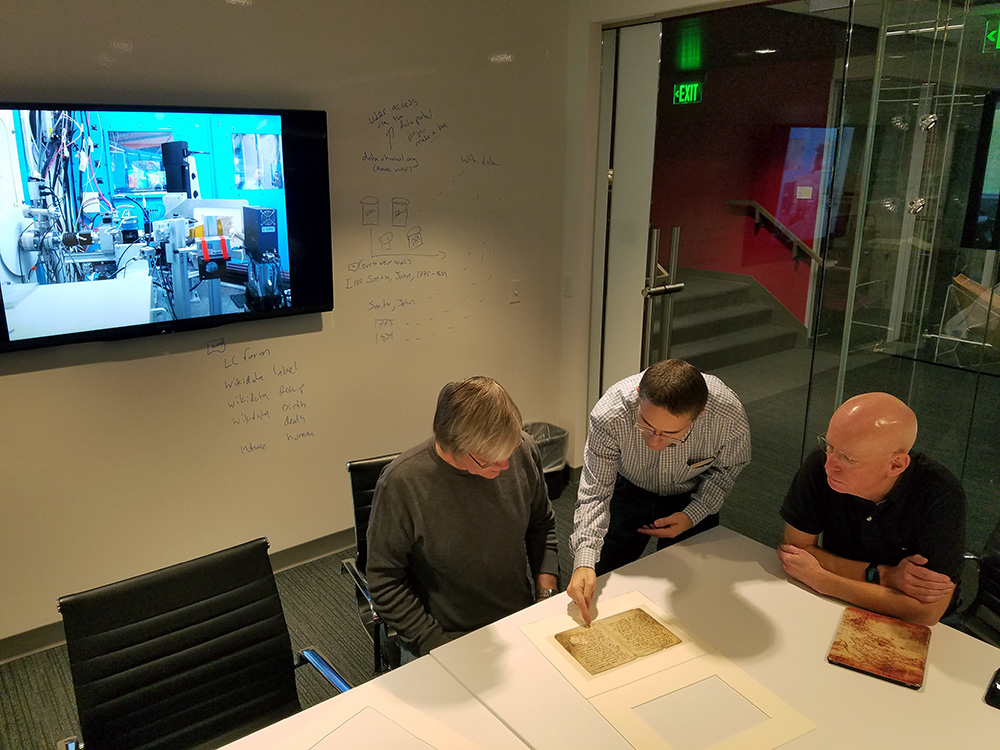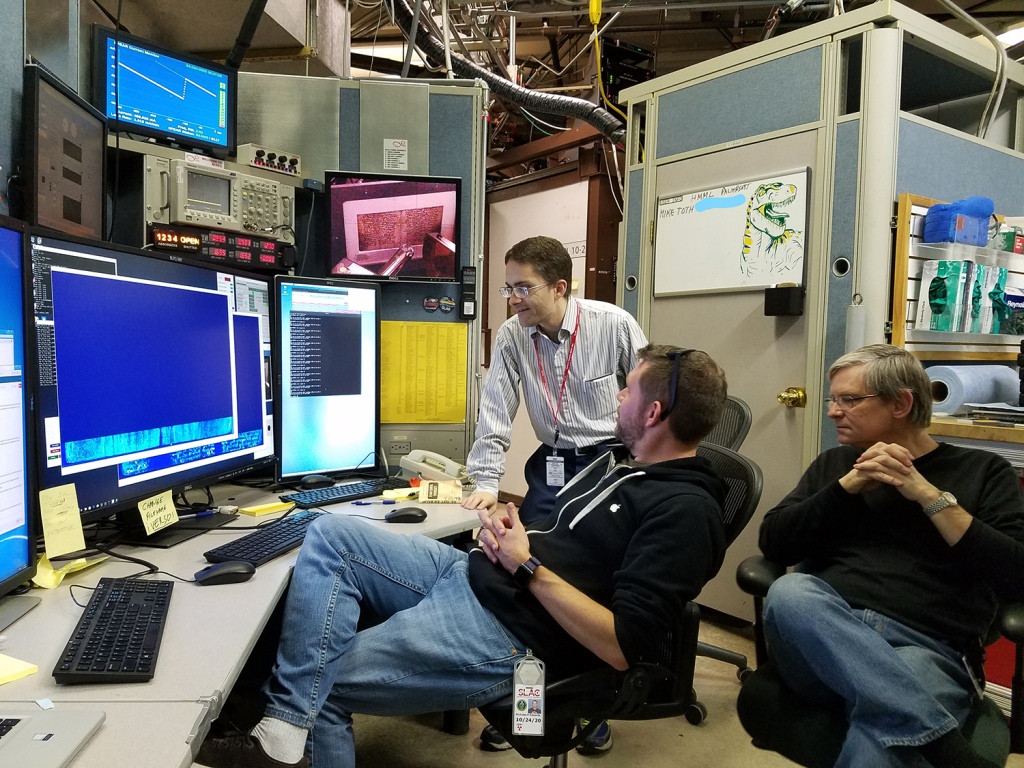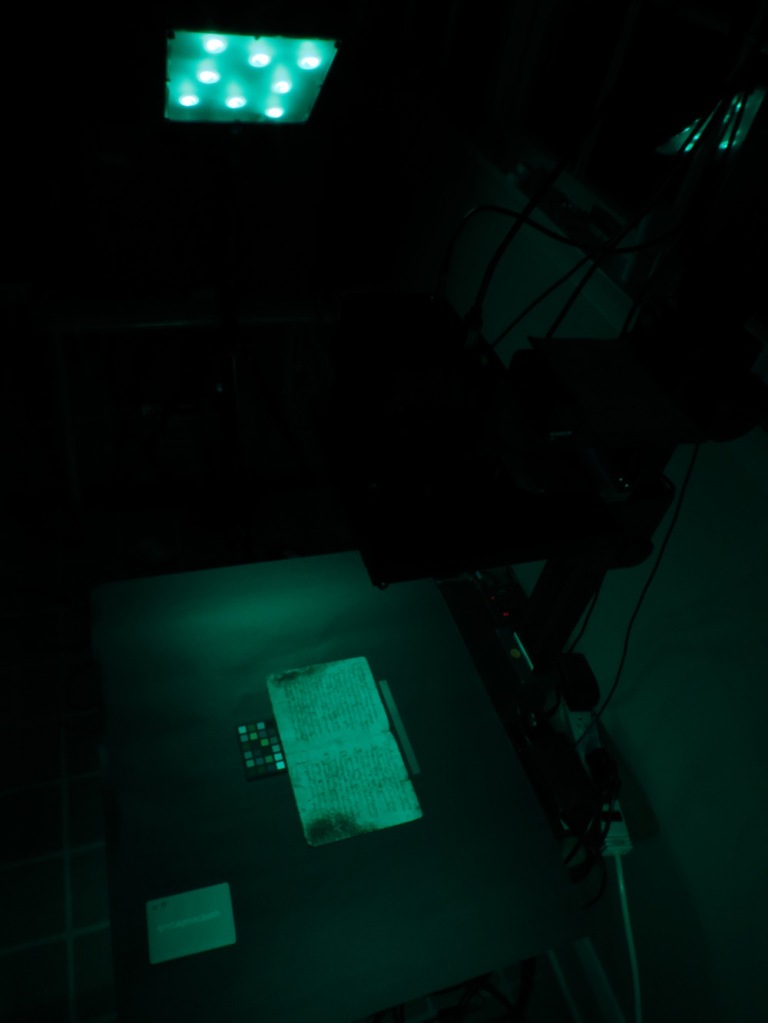By Michael B. Toth, President of R.B. Toth Associates

On May 18, 2020, the Schoenberg Institute of Manuscript Studies (SIMS) began hosting image data on OPenn for its 48th data repository, the Hill Museum & Manuscript Library (HMML) a library and cultural heritage organization located in Collegeville, Minnesota. The new addition is a palimpsest manuscript leaf (a bifolium) from a Georgian book of liturgical chants dating to the late 10th century. The palimpsest, whose earlier writing was scrubbed-off so the parchment could be reused, is SJU Ms Frag 32 and contains two erased Syriac undertexts written between the 6th-8th centuries. The fragment, part of HMML’s rare book collection, comes from a larger manuscript that was in circulation in early monastic communities of Mesopotamia and will offer a rich array of information about the production and use of books by religious communities in the ancient Near East.
The HMML palimpsest, SJU Ms Frag 32, joins the Archimedes and Syriac Galen palimpsests on the SIMS OPenn site, and brings together data collected across a year and a half of wide-ranging digitization studies and experiments. This work spans the United States with the support of multiple institutions, disciplines, and technologies. With the HMML Palimpsest data and metadata now freely available on OPenn, researchers and the general public can access the full set of captured image data and metadata. Information on the palimpsest’s history, collaborative scholarship, and imaging events will be available on HMML.org (and natural light and selected processed images hosted on HMML’s digital library, vHMML.org).
Even before advanced imaging of the HMML Palimpsest, the scholarly research team at HMML began piecing together the history of the parchment fragment. As Melissa Moreton, HMML Assistant Director for Strategic Initiatives, noted:
“SJU Ms Frag 32 was initially described only as a bifolium in Armenian, likely copied in the 17th-century. HMML’s Curator of Western Collections Matthew Heintzelman noticed faint traces of erased writing and HMML’s Armenian cataloger, Malina Zakian, noted that the upper text was in fact Georgian, not Armenian, and much earlier than the 17th century. Though the Syriac underwriting was only faintly visible, HMML Executive Director Columba Stewart and Curator of Eastern Christian Manuscripts, David Calabro, were excited to see that it resembled a very early style of script – a rare find!”

As a palimpsest, all the information in SJU Ms Frag 32 could not be seen when viewed in natural light. When Fr. Stewart mentioned this palimpsest to me, I readily agreed it would be a great candidate for narrowband multispectral imaging during testing of our latest imaging system in our Washington DC area labs. Little did we know how complicated this palimpsest was – and the amount of imaging that would ultimately be required over the next 18 months to gather all the information the laws of physics currently allow. In a much longer tale than this piece allows, in collaboration with HMML and others, we ended up imaging the HMML Palimpsest not only in narrow bands of ultraviolet, visible and infrared light, but also with a powerful X-ray synchrotron in California.

The latter was accomplished with a team of scientists and technical experts at the SLAC National Accelerator Laboratory. From these XRF images the scholars concluded the palimpsest contained not just one, but two layers of Syriac undertext from the 6th and 8th centuries. Additional scholarly research will be required to truly analyze and understand the large amounts of data from all this imaging.
After the imaging was completed, we then transferred to SIMS all the captured image data from the multispectral and XRF imaging as TIFF images with the help of Doug Emery and Jessica Dummer at the University of Pennsylvania Libraries. Thanks to their work, the complex sets of image data were ingested without any apparent issues. SIMS’s high data standards and focus on preserving image data in context led to the creation of the all-important metadata and ReadMe documents and instructions to render them for full digital access and preservation.
The images hosted on OPenn represent two different imaging methods, with another available on the virtual HMML online library, vHMML.org. More information is available in various papers about the imaging, but in order of imaging, the data sets comprise:
1. Digitization: Digitization starts with good quality color images. The natural light images of SJU Ms Frag 32 were captured at HMML and hosted on vHMML.org. The platform offers users the ability to enhance and compare images with zoom, exposure, and contrast features using the Mirador viewer.
2. Narrowband Multispectral Imaging (MSI): For each side of the HMML Palimpsest we captured “stacks” of registered images with our integrated multispectral imaging system. This included a Phase One achromatic 100MP camera and the latest Equipoise Imaging narrowband illuminators. Each complete stack took about 5 minutes to capture – which is relatively quick by narrowband imaging standards. These were then digitally processed to produce representative pseudocolor images. With access to the captured MSI images on OPenn, users are able process their own images to meet their research needs and visual acuity (or lack thereof).

3. X-ray Fluorescence (XRF): Evidence of text that could not be read with optical multispectral imaging then required us to turn to SLAC for XRF scanning at the Stanford Synchrotron Radiation Lightsource. Each scan took 10-12 hours, half the time of the early Archimedes Palimpsest imaging at SLAC in 2006. Again we wound up with stacks of images, but this time with each created from the energy given off by each element detected on the leaf. These and similarly processed images are also hosted on OPenn.
The range of imaging and the hosting of all this data, even for a single bifolio, takes the support of a broad team and institutions. In addition to the people cited above, this includes Bill Christens-Barry of Equipoise Imaging LLC; Melissa Moreton, David Calabro, Wayne Torborg, Tim Ternes, and others at HMML; Uwe Bergmann, Nick Edwards, Sam Webb, Beam Operators and many others at SLAC SSRL; the team at SIMS and the Kislak Center in the University of Pennsylvania Libraries, as well as Will Noel, now at Princeton Library; Dr. Cerys Jones who just completed her PhD studies at UCL; Kristen St. John, conservators and others in the Stanford University Libraries Preservation Department; SSRL at SLAC supported by the US Department of Energy, Office of Science, Office of Basic Energy Sciences, under Contract No. DE-AC02-76SF00515.
About the author: Michael B. Toth, president of R.B. Toth Associates, is an international leader in the use of advanced imaging solutions for manuscript and cultural heritage studies around the globe and a long-time friend of SIMS. With 30 years of system engineering and program management, he leads teams of technical experts and scholars as they make previously unknown cultural heritage openly available for online research. Mike graduated from Wake Forest in 1979 and worked for the Federal Government for 28 years before heading up R.B. Toth Associates, founded by his father in 1982. http://rbtoth.com.
